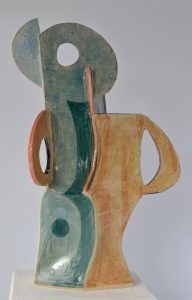Capriccio
Ceramics is more than just playing with mud, as has been discussed on this site before. It ranges from the functional and commercial to the personal and expressive, from pieces that demand no attention because they exist to hold a pile of sandwiches to pots that require effort from the viewer as you move around the object, examining details and angles that provide an emotional connection with the maker.
In London recently, and on a visit to The Sunday Painter gallery, the work of Angus Suttie (1946 – 1993) was on display. His approach was described as “tapping the subconscious to see what happens”, and he turned out work that is humorous, direct and engaged. Strong vertical or horizontal shapes, with twisted forms, holes and conduits, piled-up different forms from smaller parts, playful and probably unplanned from the start, they are “awkward and beautiful” as he himself described the work. The exhibition is on until 26th October – click here for the link, if you’re anywhere near the South Lambeth Rd, drop in.
That element of play is important. Starting out without a clear plan or design in mind can lead to all sorts of interesting outcomes, specially with hand-building when you can cut the clay and shape it as you build your piece. At Peter Arscott Ceramics the vessel is still king, and is the basis for all work, but sometimes functionality is not obvious, or, rather, not relevant, as the personality of the piece takes shape – often in a whimsical direction.
“Whimsical” is such a strange-sounding word. “Whimsical derives from whim-wham, a noun from the early 16th century that originally referred to an ornamental object or trinket. Later whim-wham, with its fun sound, came to refer to a fantastic notion or odd fancy” (Merriam-Webster dictionary). So that explains it: whimsical, quirky, capricious.
There is nothing capricious about setting off to walk up to Bradlow Knoll – it is a serious undertaking for two-legged beings of a certain age whose gamboling days are long behind them. However, this latest walk led to an encounter which put a spring in the step, as the recent fencing layout on the hill was eventually explained by the number of goats grazing. As all walkers know “When setting out upon an important journey, it’s good luck to meet a goat.”
Apologies for my lexicographical meanderings – it’s probably a phase. There are two theories as to how the word “capricious” is derived. It comes via French from the Italian word capriccio, which originally referred not to a sudden desire but to a sudden shiver of fear. It probably comes from the Italian capo, meaning “head,” and riccio, the word for “hedgehog” – anyone who shuddered in fear was said to have a “hedgehog head,” meaning that the person’s hair stood on end like the spines of a hedgehog.
My preferred theory is the possible link to Italian word “capra”, meaning “goat,” because of the animal’s perceived whimsical nature. Anyway, they are sociable animals, intelligent and curious, and, thanks to them, coffee was first discovered when Ethiopian goat herders noticed the animals acting energetically after nibbling coffee beans, though I prefer the version where the abbot of a monastery full of lazy monks saw the effect on his goats and fed the beans to his brethren.
St Spyridon, patron saint of potters and former goat herd, known by the PAC team in the studio simply as Spiro (in charge of Marketing) is keen that we know that goats are one of the cleanest animals, though they dislike water and would rather leap over streams and puddles than step in them. They also use the sneeze sound to warn each other of danger. Fact: the pharaoh Cephranes thought that so much of his goats that he had 2,234 buried with him. Spiro also says that goat yoghurt is the best – that’s all he eats.
As you can see from the image at the start of this blog, the view from Bradlow Knoll in early October gives every appearance that summer is still with us. The only tree that is turning autumnal is the horse chestnut, and there are not many in the neighbourhood: ash, hawthorn, hazel, blackthorn, sycamore and apple are more common in Herefordshire. This time of year is all about apples and cider-making, and in the cluster of villages around Much Marcle, the Big Apple Harvest festival takes place on 12th and 13thOctober. You can visit the local orchards, see, hear and smell cider and perry being made and taste and buy many different varieties of apples, local ciders, perries and apple juices. Click here.
Michaelmas daisies are all out now. They are a sure sign of Autumn and are so called because they reach their peak on or around the 29 September, Michaelmas Day, or The Feast of Michael and All Angels, signifying the end of the harvest, the start of autumn and the beginning of the shorter days.
A couple invited the local vicar for Sunday dinner. While they were in the kitchen preparing the meal, the minister asked their son what they were having.
“Goat,” the little boy replied.
“Goat?” replied the vicar, “Are you sure about that?”
“Yes,” said the youngster. “I heard Dad say to Mom, ‘Today is just as good as any to have the old goat for dinner.’








































































































































